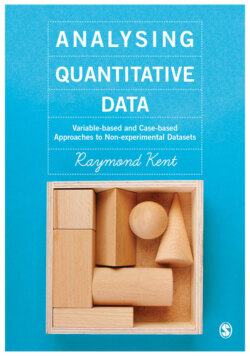Читать книгу Analysing Quantitative Data - Raymond A Kent - Страница 38
На сайте Литреса книга снята с продажи.
Creating class intervals
ОглавлениеThese are used to group together ranges of values on metric measures to enable the researcher to get an overview of the distribution. The intervals must be non-overlapping and as far as possible of the same width. In the alcohol marketing data, young people were asked whether or not they had seen adverts for alcohol in any of 16 different channels, and a new variable, Total number of channels seen (Totalseen), was created. Figure 2.7 shows the frequencies for each number of channels. Thus 33 claim to have seen no adverts for alcohol on any of these listed channels, one had seen them on all channels, but the majority, just over 50 per cent, said they had seen them on between four and seven channels. The creation of class intervals may be approached in a number of ways. From the Cumulative Percent column, you can see that nearly 50 per cent (49.3 per cent) had seen such adverts on up to five channels. If the researcher wanted to create a two-value measure, then the 920 cases could be split into those who had seen alcohol adverts on up to five channels and those who had seen six or more channels, as shown in Figure 2.8. This is not a binary measure in the sense that Six or more channels seen is not the ‘absence’ of membership of the category Up to five channels seen. It is really a two-value nominal measure – a dichotomy. Furthermore, the latter category includes the 33 who said they had not seen any. These do not sit well in any classification of the number of channels in which alcohol adverts were ‘seen’. It would make sense to keep the 33 as a separate category in the three-value measure in Figure 2.8. Another option is to treat the 33 as ‘missing values’ and exclude them from the table. The treatment of missing values is considered later in this section.
The two- and three-value solutions above can be considered not so much as ‘intervals’ as ordered category solutions. To keep the measure metric, the number of channels in which adverts for alcohol were seen could be grouped into several intervals of equal width, for example, of three channels, 0–2, 3–5, 6–8, 9–11, 12–14 and 15–16. The last interval is only two channels: nothing is ever perfect and compromises have to be made. The usefulness of doing this is limited when there are few values to be grouped. However, if there were 100 or so (as there would be with age in years for individuals), then grouping into class intervals (of perhaps 10 years) and obtaining a frequency distribution would enable the researcher to overview the entire distribution pattern in a simple table.
Figure 2.7 Number of channels on which adverts for alcohol have been seen
Figure 2.8 Figure 2.7 recoded into two- and three-value measures
The number, width and placing of the intervals are matters for researcher judgement and may be subject to trial and error, with the researcher trying out different groupings to see to what extent this may affect the results. To view a distribution a useful rule of thumb is to create between about 5 and 15 intervals. If there are outliers – values that are substantially different from the general body of values – then there may need to be open-ended classes at either or both ends of the table. This is quite a common way of dealing with extreme values, but it does mean that the width of the open-ended intervals is unknown. Creating class intervals in SPSS is explained in Box 2.3.
